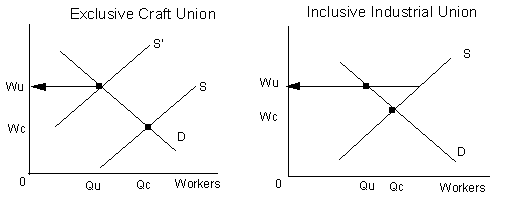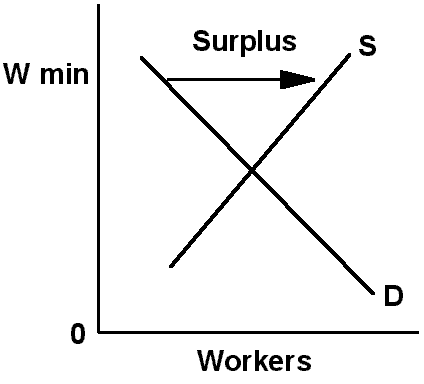V. Unions
A. Introduction
1.
A union is an organization of workers
selling their
services collectively.
2.
Unions have many goals.
a. Primary goal of higher income is
becoming less important.
b. Recent emphasis has been on employment security.
B.
Methods of achieving higher wages.
1.
Increase demand (MRPL) for labor a.
Increase product demand
a. Advertising the union label
b. Sponsoring trade restrictions such as tariffs and quotas
2.
Increase the productivity of workers
a. Encourage cooperation with labor-
management committees
b.
Negotiate worker training and
education programs
3. Control the supply of workers hired
a .Require apprenticeships, licenses
.
b. Restrict immigration and child labor
c. Encourage shorter workweek and
family leave programs
d. Keep jobs management
wants to eliminate (featherbedding)
e.
Require closed shops which limit
hiring to union members
f. Require union shops
where new
workers to join after a set period
g. Against open shops where all may work, joining union is voluntary
C. Craft Unions
1. Organized in 1886 by
Samuel Gompers as
American Federation of Labor -AFL
a. Each trade was autonomous
b. Union was not political
2. Skilled workers were organized.
3. High skill requirements naturally limited supply and unions tried to
reinforce limited supply.
4. Tried to shift supply of workers to the left with licensing,
apprenticeships, child labor
laws, etc. to increase wages.
D. Inclusive Industrial Union
1. Congress of Industri
Organizations (CIO) was organized in 1936
John L. Lewis who
broke with the AFL because mass
production workers
need a their own organization.
See
Decline and resurgence of the U S
auto industry
2. Unskilled workers were organized.
3. Limited skills make limiting supply impractical.
4. Controlled supply of workers and emphasized collective bargaining to increase wages.

Wagner Act
National
Labor Relations
Act of
1935 became known as the "Magna Charta" of
labor because it increased union power.
1. It made
company-sponsored unions
illegal, stopped company interference with unionizing activity (strikes), prohibited discrimination
against union
members, and required companies
to
bargain in good faith.
2. National
Labor Relations Board set up to investigate/stop
unfair
labor
1. Outlawed a closed shop where companies must hire union members.
2. Allowed state right-to-work-laws make union shops requiring workers eventual become union members
, illegal in 21 states. (Right to Work States)
3. Outlawed Featherbedding (keeping positions even though there is no need, i.e.firemen on a electric train)
4. Secondary boycotts or sympathy strikes (companies the employer does business with also feel a boycott)

